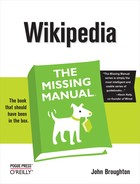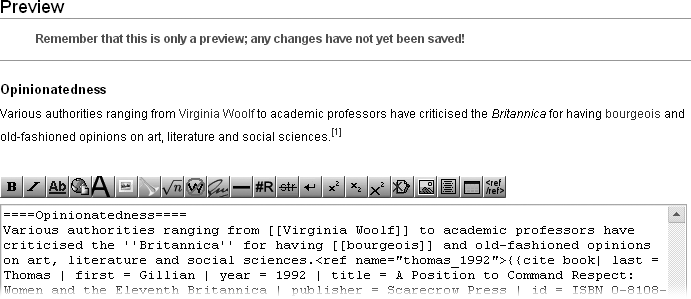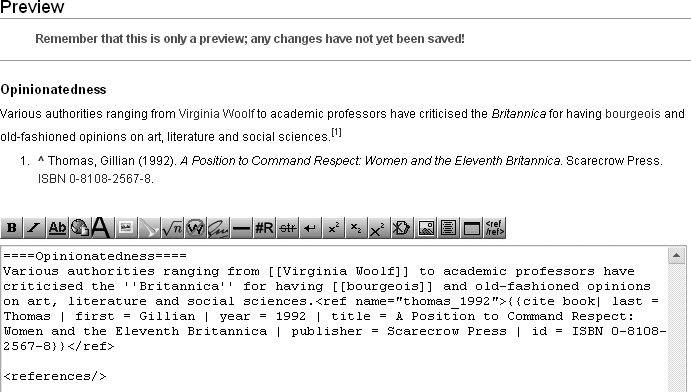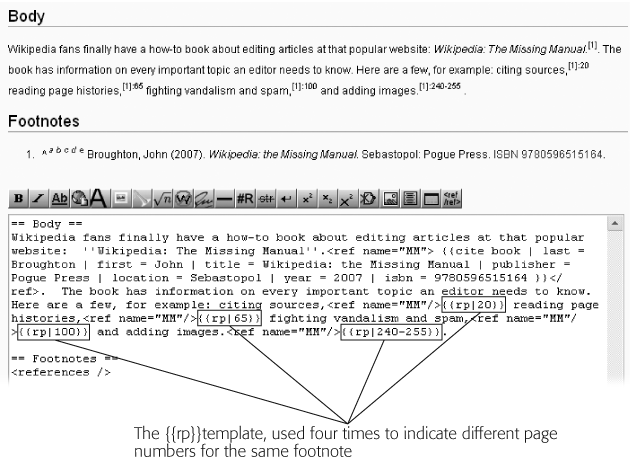With what you’ve learned so far, you now know how to document information in Wikipedia in just about any situation—you can create links, footnotes, and multiple footnotes, and use citation templates. The three techniques described in the rest of this chapter are completely optional. But if you spend a lot of time creating and editing citations, you may find a need for automated citation-creating tools, viewing footnotes for just a section of an article, and adding page numbers to footnotes.
When you want to cite a source, you usually have to cut and paste various elements—one by one—from the Web page where you found the source into the edit box where you’re assembling the citation. But sometimes, computerized tools can vastly simplify your work: You can simply cut and paste the whole citation, not its individual parts. Here’s an assortment of tools to check out:
If you start a Google Scholar search with the Wikipedia {{citation}} Assistant at http://toolserver.org/~verisimilus/Scholar/, you can just click the {{Wikify}} link that’s part of each search result. That link generates a citation for you.
For books, try OttoBib at http://www.ottobib.com/, enter an ISBN, click the Wikipedia button, and then click Get Citations.
If you have access to and use specialized databases, and know the DrugBank ID, HGNC ID, PubMed ID, or PubChem ID of a document, you can simply enter that ID into the Wikipedia template-filling page at http://diberri.dyndns.org/wikipedia/templates/. Click “Submit” to get a complete citation, ready to copy and paste.
If you use citation templates to create your footnotes, you might want to look at the Reference generator, a smarter version of the citation templates available in Wikipedia. It’s at http://toolserver.org/~magnus/makeref.php. You specify the type of citation you want (online news Web site, journal article, book, conference report, and so on), and the form then shows you the mandatory parameters (for example, the title and URL for online news), plus other optional parameters. It also shows you examples of each parameter that you might enter, so you get the format correct.
When you open only one section of an article in edit mode (which is more convenient than editing the whole article, for reasons explained on Editing Article Sections), you’ll find that you can’t see the text of footnotes when previewing your edit. For example, suppose you’re editing a section of the article Encyclopædia Britannica and you go into preview mode (see Figure 2-10).
Figure 2-10. When you edit just a section of an article, the footnote numbers are visible in preview mode, but not the text of the footnotes. Some experienced editors are comfortable saving their edits without previewing what their added footnotes look like, but if not being able to preview your footnotes makes you uneasy, see Figure 2-11 for the workaround.
The solution is to temporarily (note the emphasis) add a <references/> tag at the end of the section. Preview the section, and then delete the tag before saving your edit. Figure 2-11 shows another preview, this time with the temporary tag added.
If you’re using a book as a source, your may cite information from multiple locations within the book. If so, creating footnotes can be a challenge, because you seem to have three choices:
You can create a separate citation for every page, leading to a lot of almost-duplicate entries in the “References” section. They’d be identical except for the page number cited.
You can create a single citation with multiple occurrences, using the name= parameter as discussed on Multiple Footnotes for the Same Source. You can then list, in that one citation, all the pages numbers where you got information. (It’s better than omitting the page numbers, though not by much.)
You can use Harvard-style footnotes (???) instead of regular footnotes. (But you may be out of luck if the article already has a significant number of regular footnotes, because other editors may object to mixing the two styles.)
Fortunately, there’s a fourth option, using a citation template called Rp. It lets you slot in the page number right next to the footnote number, where your readers can readily see it. Figure 2-12 shows how it works.
Figure 2-12. The Rp template lets you type page numbers when you insert multiple references to a source (bottom). They appear in superscript next to footnote numbers (top). So you can cite multiple pages from the same source without any of the problems mentioned on Adding Page Numbers to Footnote Numbers.
Note
In Figure 2-12, the ISBN is an internal link to a specialized Wikipedia page called Special:Booksources. That page in turn has links to a large number of Web sites that offer information about the linked ISBN, like online databases, general search engines, libraries throughout the world, and booksellers.



